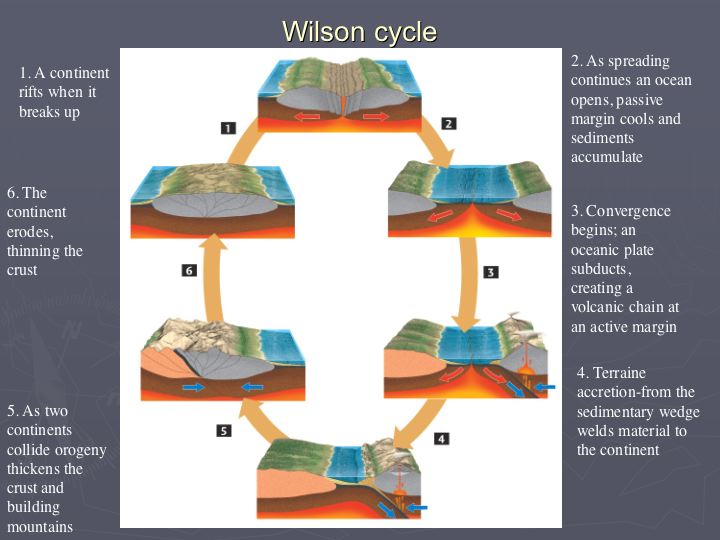There are various stages to the Wilson Cycle and each one can be seen in operation across the world today:
- The embryonic stage, involves uplift and continental crust extention, resulting in the the formation of rift valleys (e.g. the East African Rift System).
- The young stage involves the evolution of rift valleys into spreading regions with thin strips of ocean crust between the rifted continental sections. This forms a narrow, parallel-sided sea, like the Red Sea that is opening between NE Africa and Arabia.
- The mature stage is characterised by widening of basin and its continued development into a major ocean flanked by continental shelves and with the continual production of new, hot, oceanic crust along the ridge (e.g. Atlantic Ocean).
- Eventually, this expanding system becomes unstable and, away from the ridge, the oldest oceanic lithosphere sinks back into the asthenosphere, forming an oceanic trench subduction system, such as the situation in the western Pacific Ocean. Onset of subduction at the ocean boundary marks the subduction stage (e.g. the Pacific Ocean).
- Once subduction overtakes formation of new crust at the constructive boundary, the ocean begins to 'shrink'. Island arc's collide and create young mountain ranges around the periphery of the 'shrinking' ocean. This marks the terminal stage of the cycle (e.g. the Mediterranean).
- The end stage occurs when all the oceanic crust between the continental masses has subducted, and the continents converge along a collision zone characterised by an active fold mountain belt, such as the Himalayas. The plate boundary becomes inactive, but the boundary between the two plates remains as a zone of lithospheric weakness. Therefore it has the potential to the site of a new rift and so the cycle continues.

The US has 750 miles of Rough mountains on the west coast representing the last phase of the NW movement of the the Plate across the Pacific basin unencumbered by land masses until it subducted the Wyoming Kraton leaving the Craters of the moon national park monument as it's signature for 120 miles or so to the Yellowstone Hot spot. The 800 miles of Plains to the East coast indicates there was no subduction taking place. Had there been we would have mountains there.
ReplyDeleteThus it looks like the slower rotation speed of the planet from 22hrs/ day to 24hrs/day is due to the additional surface area. We assume there was subduction but in fact the Magma mixed with air and created light weight Granite which floats atop the mantle rock. YES?